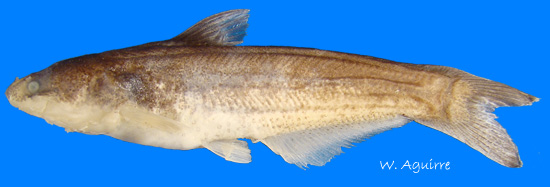Cetopsidae - Paracetopsis bleekeri Bleeker, 1862 |
 |
| SOURCE FOR OCCURRENCE IN ECUADOR: This species occurs in the Guayas and Santa Rosa river basins of southwestern Ecuador. There are many references for its occurrence in the area (e.g., Eigenmann, 1922; Ovchynnyk, 1971; Barnhill et al., 1974; Glodek, 1978; Florencio, 1993; Vari et al, 2005; Ferraris, 2007; Laaz & Torres, 2010). |
| ORIGINAL DESCRIPTION: Bleeker, P. 1862-63. Atlas ichthyologique des Indes Orientales Néêrlandaises, publié sous les auspices du Gouvernement colonial néêrlandais. Tome II. Siluroïdes, Chacoïdes et Hétérobranchoïdes. Amsterdam. Tome II.: 1-112, Pls. 49-101. |
| TYPE SPECIMENS: |
| TAXONOMIC STATUS: Valid (Eschmeyer and Fricke, 2011). This species was formally known as Cetopsogiton occidentalis. |
| RANGE ECUADOR: Guayas River drainage and Santa Rosa River (Vari et al., 2005). |
| RANGE OUTSIDE OF ECUADOR: None. |
| COLLECTIONS IN ECUADOR: |
| MAXIMUM SIZE: 32.8 cm (Barnhill et al., 1974). |
| DISTINGUISHING FEATURES: Paracetopsis bleekeri is distinguished from all other species in the Cetopsinae with the exception of P. atahualpa and P. esmeraldas by the combination of the possession of a vomerine tooth patch with more than one row of teeth and a medial separation of the contralateral components of the patch. Paracetopsis bleekeri differs from P. atahualpa in the relative length of the pelvic fin (tip of fin falling short of the vent versus completely overlapping the vent, respectively), in the pigmentation on the operculum (lacking opercular pigmentation patch versus having a distinct patch of dark opercular pigmentation, respectively), the overall coloration of the head and body (light versus dark, respectively). Paracetopsis bleekeri differs from P. esmeraldas in the pigmentation on the operculum (lacking opercular pigmentation patch versus having a distinct patch of dark opercular pigmentation, respectively), in the extent of the medial gap in the vomerine tooth patch (separated by a distinct medial gap between the contralateral components of the tooth patch equivalent to the width of three or four vomerine teeth versus a limited gap equivalent to the width of one or two vomerine teeth, respectively) (Vari et al, 2005). |
| ECOLOGY: Paracetopsis bleekeri, known in Ecuador as the “bagre ciego”, is an ecologically important predatory fish (Barnhill et al., 1974). |
| ECONOMIC IMPORTANCE: This species is exploited as a food fish in rural parts of western Ecuador (Barnhill et al., 1974). |
| CONSERVATION STATUS: NA, although the species is exploited as a food species. |
| LINK TO FISHBASE PAGE: Click here for link |
| SPECIES PROFILE CREATED BY: Enrique Laaz |
| SPECIES PROFILE CONTRIBUTORS: NA |
|
|
|
|
|
